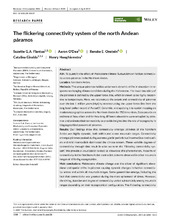| dc.contributor.author | Flantua, Suzette | |
| dc.contributor.author | O'Dea, Aaron | |
| dc.contributor.author | Onstein, Renske E | |
| dc.contributor.author | Giraldo, Catalina | |
| dc.contributor.author | Hooghiemstra, Henry | |
| dc.date.accessioned | 2020-05-20T15:32:25Z | |
| dc.date.available | 2020-05-20T15:32:25Z | |
| dc.date.issued | 2019-06-13 | |
| dc.Published | Flantua SGA, O'Dea A, Onstein, Giraldo, Hooghiemstra H. The flickering connectivity system of the north Andean páramos. Journal of Biogeography. 2019;46(8):1808-1825 | eng |
| dc.identifier.issn | 1365-2699 | en_US |
| dc.identifier.issn | 0305-0270 | en_US |
| dc.identifier.uri | http://hdl.handle.net/1956/22321 | |
| dc.description.abstract | Aim: To quantify the effect of Pleistocene climate fluctuations on habitat connectivity across páramos in the Northern Andes. Location: Northern Andes. Methods: The unique páramos habitat underwent dynamic shifts in elevation in response to changing climate conditions during the Pleistocene. The lower boundary of the páramos is defined by the upper forest line, which is known to be highly responsive to temperature. Here, we reconstruct the extent and connectivity of páramos over the last 1 million years (Myr) by reconstructing the upper forest line from the long fossil pollen record of Funza09, Colombia, and applying it to spatial mapping on modern topographies across the Northern Andes for 752 time slices. Data provide an estimate of how often and for how long different elevations were occupied by páramos and estimate their connectivity to provide insights into the role of topography in biogeographical patterns of páramos. Results: Our findings show that connectivity amongst páramos of the Northern Andes was highly dynamic, both within and across mountain ranges. Connectivity amongst páramos peaked during extreme glacial periods but intermediate cool stadials and mild interstadials dominated the climate system. These variable degrees of connectivity through time result in what we term the ‘flickering connectivity system’. We provide a visualization (video) to showcase this phenomenon. Patterns of connectivity in the Northern Andes contradict patterns observed in other mountain ranges of differing topographies. Main conclusions: Pleistocene climate change was the driver of significant elevational and spatial shifts in páramos causing dynamic changes in habitat connectivity across and within all mountain ranges. Some generalities emerge, including the fact that connectivity was greatest during the most ephemeral of times. However, the timing, duration and degree of connectivity varied substantially among mountain ranges depending on their topographical configuration. The flickering connectivity system of the páramos uncovers the dynamic settings in which evolutionary radiations shaped the most diverse alpine biome on Earth. | en_US |
| dc.language.iso | eng | eng |
| dc.publisher | Wiley | en_US |
| dc.rights | Attribution CC BY | eng |
| dc.rights.uri | http://creativecommons.org/licenses/by/4.0/ | eng |
| dc.subject | alpine biome | eng |
| dc.subject | evolutionary arenas | eng |
| dc.subject | evolutionary radiations | eng |
| dc.subject | flickering connectivity system | eng |
| dc.subject | fossil pollen | eng |
| dc.subject | mountain fingerprint | eng |
| dc.subject | neotropical biodiversity | eng |
| dc.subject | Páramos | eng |
| dc.subject | past habitat connectivity | eng |
| dc.subject | species pump | eng |
| dc.title | The flickering connectivity system of the north Andean páramos | en_US |
| dc.type | Peer reviewed | |
| dc.type | Journal article | |
| dc.date.updated | 2020-02-18T10:53:13Z | |
| dc.description.version | publishedVersion | en_US |
| dc.rights.holder | Copyright 2019 The Author(s) | en_US |
| dc.identifier.doi | https://doi.org/10.1111/jbi.13607 | |
| dc.identifier.cristin | 1716220 | |
| dc.source.journal | Journal of Biogeography | |

